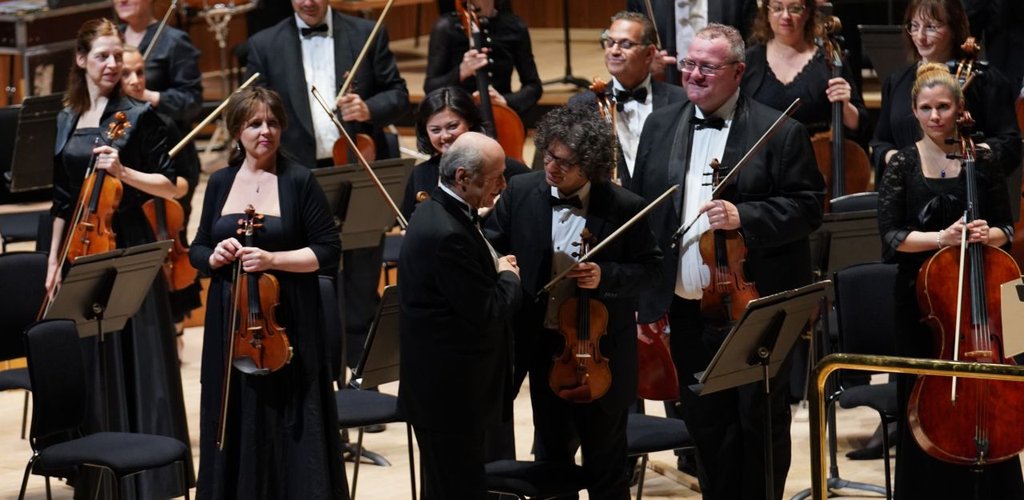A charismatic, idiomatic account of Mahler's Ninth from the great Hungarians. Critical review by Boyd Tonkin in Art Desk.
Standing ovations on the less-than-passionate South Bank can have a dutiful, grudging quality. However, I’ve seldom heard more heartfelt ardour at the Royal Festival Hall than the acclaim for Iván Fischer and the Budapest Festival Orchestra last night. Rightly so? Beyond all doubt.
We knew, from recordings if not live performances, that their stewardship of Mahler’s Ninth Symphony passes beyond curatorial respect and into a sort of rapturous renewal. We’ll never quite hear Mahler’s Ninth (though Bruno Walter certainly comes close). Still, the great Budapest band arguably embodies the all-encompassing, tragi-comic sound-world of this astonishing score more completely than any of their peers.
Fischer avoids steamroller pomposity. Over the four supremely audacious movements, it’s up to us to decide where the balance between hope and dread, light and dark, elegy and tragedy, belongs. I left not really caring whether the symphony’s final account testifies to an affirmation of life, or a weary reconciliation with death: what mattered was the journey, on which every detail blazed.
Fischer never dawdled, and seldom lingered. But, although sometimes swift, no element felt over-hasty. When time-defying stillness was required – above all, in the Sehr langsam farewell adagio – he didn’t hold back. The eight superb basses lined up at the back like heavy artillery (and, at moments, had the same earth-shattering impact). Otherwise, Fischer’s agile, quicksilver and supremely flexible hands fronted a music of dialogue, dispute and contradiction.
The orchestral geography expresses this to-and-fro of longing and grieving, as (say) trombones and horns quarrel lustily across the stage, or the second violins set out on wayward lyric journeys of their own. Fischer used these distances to intensify the micro-drama of each change of mood. Pack every scene with such dense colour, as he does, and the shape of the overall picture takes care of itself.
In the opening Andante comodo, we heard the sheer precision of Fischer’s quietness: his pianissimos can thrill as much as his hall-shaking climaxes. Muted horns and tender strings – led by Daniel Bard (pictured above with Iván Fischer) – introduced the faraway, yearning note that always sounded here even in the eye of the storm, while that famous irregular heartbeat jittered ominously along. As the first movement’s tone darkens, the idiomatic verve of the Budapest players gave us sardonic, ironic accents galore but never (it seemed) outright cynicism. Behind the hints of mockery in brass and woods, there was always a willingness to rise, or fall, into dreamy nostalgia and courtly grace. His terrifying, centrifugal tutti aside, Fischer made you understand here why listeners find echoes of a Strauss waltz here. The flutes (led by Gabriella Pivon) sounded gloriously warm and wistful, as Balázs Szakszon and his trombones began (as they continued) with swaggering menace.
Fischer is always a treat to watch as well as hear: in the twisted ländler of the scherzo, he positively bounced through the stuttering dance as the orchestra delivered a sophisticated performance of tipsy, rustic earthiness. Fischer swung us shamelessly to the edge of kitsch, and a step beyond, with playing that managed at the same time to sound both bracingly tight and anarchically loose. Lurching, squawking woods delighted, here and throughout, none more so than Bence Bogányi and the wonderfully flavourful Budapest bassoons.
In the Rondo-Burleske, utter breakdown threatens, but Fischer kept it at bay. Here his intrinsically dramatic, or dialectical, vision of the Ninth came into its own. The snarling repartee between instruments and sections – smeary, slashing brass to the fore – shot back and forth across and around the stage. We appreciated the extraordinary breadth and depth of the sonic palette Fischer paints with; nothing felt uniform or standardised. He pinpointed, too, the passages of relief or escape – in the trumpets, for instance – that mitigate this drive towards chaos.
For many devotees, the meditative ecstasy of the slow fourth movement makes or breaks a Ninth. Fischer gave it everything. His impassioned, moment-by-moment guidance never let the aching transcendence of the string theme – with its salute to Beethoven’s Les Adieux sonata – coalesce into a syrupy blur. His ultra-expressive left hand delivered a Mahler masterclass by itself: quivering, imploring, coaxing, blessing; exquisitely sensitive to each minute shift in tempi and dynamics. The sumptuous horns, led by Zoltán Szöke, capped an evening of stellar achievement, while the flutes again ascended into their own, heavenly sphere. As for the string sound, it had both ravishing, voluptuous depth overall, and delicious finesse in the detail and solo excursions: notably, with Csaba Gálfi and the violas.
As the finale, after its echo of Mahler’s Kindertotenlieder, faded achingly away into silence, I stopped wondering if the ersterbend marking of the closing pages hints at total extinction or just serene leave-taking. The gossamer fragility and purity of the high strings made their own case. Fischer enriched this near-silence as eloquently as he had the brazen, full-spectrum theatricality of what has gone before. Thankfully, the audience rewarded his sensitive leadership with a long, breath-stopping hush once all sound had at last ceased. Then came the roar.
